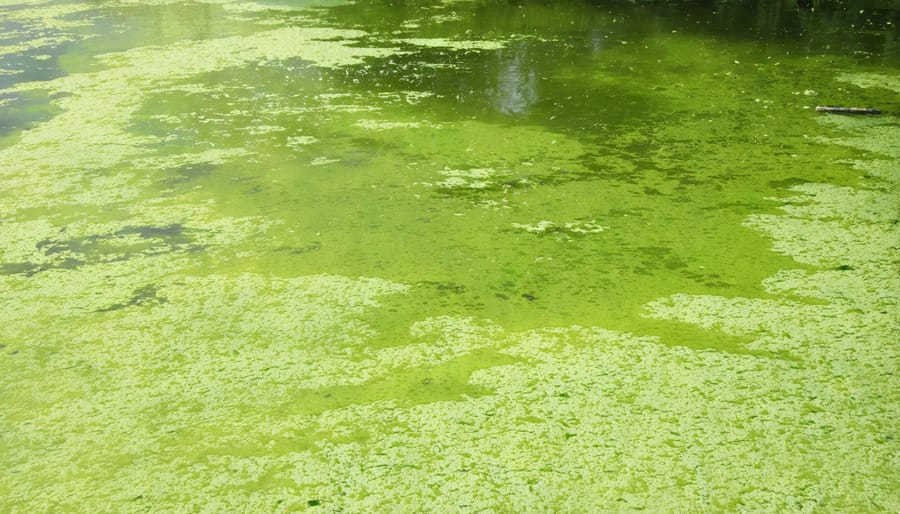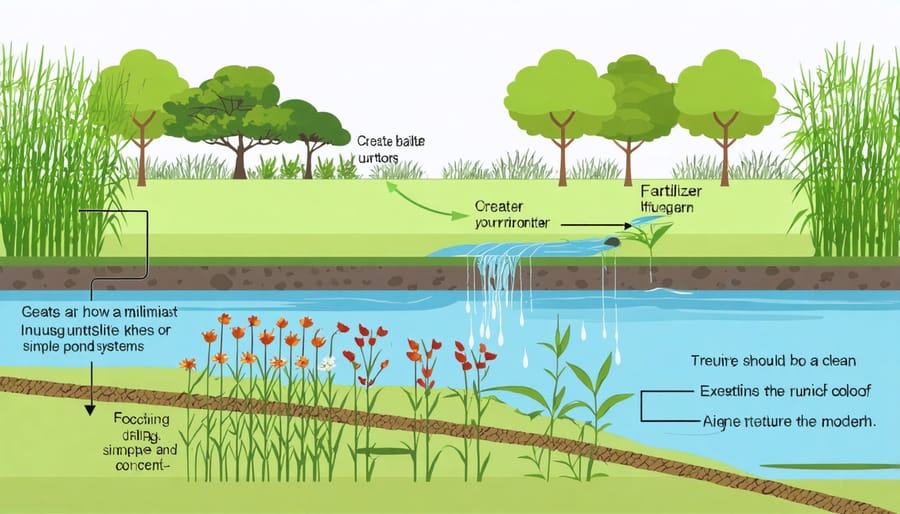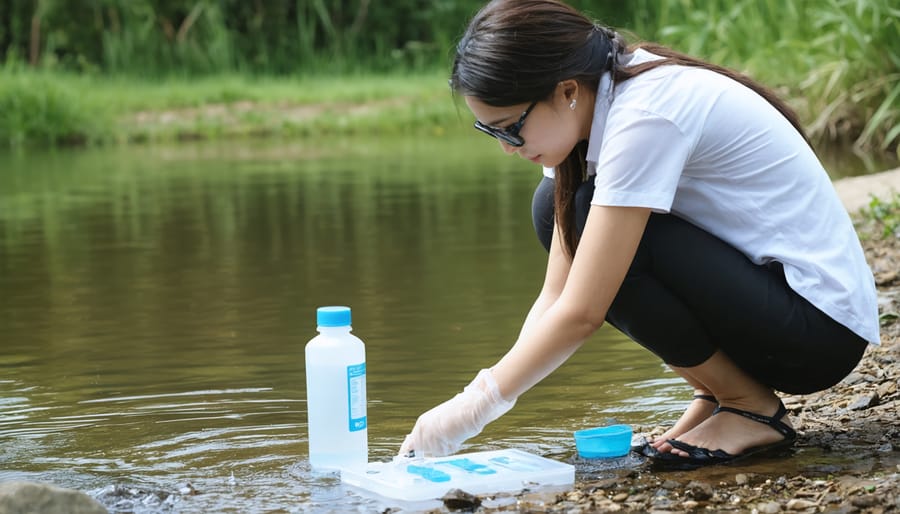
Protect Your Pond Fish from These Deadly Water Toxins
Test pond water weekly for toxic algae blooms, checking specifically for blue-green growth and measuring dissolved oxygen levels. These hidden dangers in pond water can rapidly devastate fish populations if left unchecked. Install an emergency aeration system to quickly combat sudden toxin spikes, particularly during warm summer months when dangerous compounds concentrate. Monitor fish behavior daily – gasping at the surface, lethargy, or unusual swimming patterns signal potential toxin presence. Create a natural defense system by maintaining beneficial bacteria colonies and aquatic plants that compete with harmful algae for nutrients. The battle against aquatic toxins requires vigilance, but with proper monitoring and quick action, your pond can thrive as a healthy ecosystem for years to come.
Common Natural Toxins in Pond Water
Algal Toxins and Blue-Green Algae
Blue-green algae, also known as cyanobacteria, can turn your peaceful pond into a toxic soup when conditions are right. These microscopic organisms multiply rapidly in warm, nutrient-rich water, forming what we call harmful algal blooms (HABs). While not all blooms are dangerous, some produce toxins that can be deadly to fish, pets, and even humans.
The most common signs of a toxic bloom include a paint-like green scum on the water surface, an unpleasant musty odor, and water that looks like pea soup. These blooms typically appear during hot summer months when water temperatures rise and there’s plenty of sunlight.
To protect your pond from toxic algal blooms, focus on prevention. Maintain proper water circulation, avoid overfeeding fish, and regularly remove dead plant material. Adding beneficial bacteria and installing UV clarifiers can help keep algae populations in check. If you spot signs of a harmful bloom, it’s best to keep pets and children away from the water and consult a water quality expert for proper treatment options.
Remember, not all green water means danger, but it’s better to be safe than sorry when dealing with potentially toxic algae.

Plant-Based Toxins
When pond plants die and begin to decompose, they can release harmful substances into the water that affect both fish and water quality. This natural process becomes particularly concerning during autumn when leaves fall into the pond or when aquatic plants reach the end of their lifecycle. The decomposing plant material releases tannins and other organic compounds that can deplete oxygen levels and create an unhealthy environment for pond life.
Dead plant matter can also release phenols and other chemical compounds that, in high concentrations, may stress or harm fish. These substances often turn the water brown and create an unpleasant odor. Regular removal of dead plant material is essential to prevent these toxins from building up in your pond.
To minimize plant-based toxins, use pond nets during fall to catch falling leaves, trim dying plant material promptly, and maintain a healthy balance of plants in your pond. A good biological filtration system and regular water testing can help manage these natural toxins effectively. Remember that some decomposition is normal and even beneficial in small amounts, as it provides nutrients for beneficial bacteria and other micro-organisms in your pond’s ecosystem.
Human-Introduced Toxins
Fertilizer and Pesticide Runoff
Garden chemicals can pose a serious threat to your pond’s ecosystem when they find their way into the water. Even small amounts of fertilizers and pesticides from nearby lawns and gardens can create big problems for your aquatic paradise. Fertilizer runoff often leads to excessive algae growth, as the extra nutrients fuel these unwanted plants, while pesticides can harm or kill beneficial bacteria, plants, and fish.
To protect your pond, create a buffer zone of at least 3 feet between treated areas and your pond’s edge. Consider using organic gardening methods near your water feature, and always apply chemicals on calm days to prevent wind drift. Installing a rain garden or strategic drainage can help redirect contaminated runoff away from your pond.
If you suspect chemical contamination in your pond, look for warning signs like sudden algae blooms, fish gasping at the surface, or unexplained plant die-off. Regular water testing can help you catch problems early, and adding activated carbon to your filtration system can help remove some chemical contaminants. Remember, prevention is always easier than treating contamination after it occurs.

Household Chemical Contamination
Common household chemicals can pose serious risks to pond ecosystems when they accidentally enter the water. Even small amounts of cleaning products, laundry detergents, or car wash runoff can disrupt the delicate balance of your pond. These chemicals often contain phosphates, surfactants, and other harmful compounds that can damage fish gills, destroy beneficial bacteria, and promote excessive algae growth.
Be especially careful with bleach-based cleaners, window washing solutions, and pressure washing chemicals. These products can quickly raise toxicity levels, even in diluted forms. To protect your pond, always direct runoff away from water features when cleaning outdoor surfaces. Consider using eco-friendly cleaning alternatives like vinegar and baking soda for outdoor maintenance near your pond.
Create a buffer zone of at least 10 feet between areas where you use cleaning products and your pond. Install proper drainage systems to prevent chemical-laden water from flowing into your pond during rainstorms. If you suspect chemical contamination, immediately perform a partial water change and monitor your fish for signs of distress, such as rapid gill movement or unusual swimming patterns.
Signs of Toxic Water Problems
Keeping a watchful eye on your pond’s inhabitants can help you spot toxic water problems early. Fish are excellent indicators of water quality issues, and their behavior often signals trouble before it becomes severe. If you notice your fish gasping at the surface, swimming erratically, or showing reduced appetite, these could be warning signs of toxic conditions in your pond.
Physical symptoms in fish include reddened gills, unusual spots or discoloration, and clamped fins held close to the body. You might also observe them rubbing against rocks or pond edges, which typically indicates they’re trying to relieve irritation from poor water quality.
Your pond plants can also tell you when something’s wrong. Watch for yellowing leaves, stunted growth, or unusual algae growth. If normally healthy plants start dying without obvious cause, toxic conditions might be the culprit. An excessive bloom of algae often indicates high nutrient levels, which can lead to toxic conditions.
The water itself provides clues too. Keep an eye out for:
– Unusual colors or cloudiness
– Strong, unpleasant odors
– Oily films on the surface
– Foam or bubbles that don’t disperse
– Dead insects or small animals near the water
Morning hours are particularly telling – if you notice fish gulping at the surface just after sunrise, your pond likely has overnight oxygen depletion issues, which can contribute to toxic conditions.
Remember that these signs often appear gradually, so maintaining a regular observation routine helps catch problems early. Quick action when you notice these symptoms can prevent more serious issues from developing.
Prevention and Treatment Methods

Water Testing and Monitoring
Regular water testing is your first line of defense against aquatic toxins. A simple weekly testing routine can help you catch potential problems before they harm your pond life. Start by testing the basics: pH, ammonia, nitrites, and nitrates using a reliable test kit. These parameters directly affect how toxic certain compounds become in your water.
For best results, test your water at the same time each week, preferably in the morning before feeding your fish. Keep a logbook to track changes over time – this helps you spot concerning trends early. If you notice unusual readings, increase testing frequency to daily until values normalize.
Don’t forget to test your water source too, especially if you’re doing water changes. Even treated tap water can introduce unexpected toxins. Having a proper filtration system helps maintain stable water parameters, but it shouldn’t replace regular testing.
During seasonal changes or after heavy rains, consider testing for additional parameters like dissolved oxygen and phosphates. These simple steps can save you from costly problems down the road and keep your pond healthy year-round.
Natural Detoxification Solutions
Nature provides several effective solutions for managing aquatic toxins in your pond ecosystem. One of the most powerful methods is incorporating specific aquatic plants that act as natural filters. Water lilies, cattails, and rushes not only add beauty to your pond but also absorb excess nutrients and harmful compounds through their root systems.
Creating a balanced ecosystem through natural pond oxygenation helps break down toxins naturally. Adding beneficial bacteria supplements can accelerate this process, as these microscopic helpers digest organic waste and convert harmful ammonia into harmless compounds.
Activated charcoal or carbon is another natural solution that works wonders in removing toxins. Simply place it in mesh bags near your pond’s water flow areas. Regular water movement through fountains or waterfalls also helps by increasing oxygen levels and preventing stagnation where toxins typically build up.
For smaller ponds, adding barley straw has proven effective in controlling algae growth and reducing certain toxins. Remember to replace it every few months for continued effectiveness. These natural methods work best when combined as part of a comprehensive maintenance routine.
Emergency Response Steps
When you detect toxic conditions in your pond, act quickly! First, test your water immediately using a comprehensive water testing kit to identify specific problems. Next, perform a 25-30% water change right away, using dechlorinated water. Move your fish to a temporary holding tank if you notice any signs of distress, like gasping at the surface or unusual swimming patterns.
Turn on all available aerators and fountains to maximize oxygen levels, and remove any dead plant material or debris. Stop feeding your fish temporarily to reduce waste production. If you have activated carbon on hand, add it to your filtration system to help absorb toxins.
Document all symptoms and water test results – this information might be crucial if you need professional help. If fish deaths occur or conditions don’t improve within 24 hours, consult an aquatic specialist immediately. Remember, prevention is always better than cure, so establish a regular water testing routine.
Maintaining a healthy aquatic environment requires ongoing vigilance and regular monitoring of potential toxins. By staying proactive with water testing, proper filtration maintenance, and careful observation of your fish and plants, you can prevent many common toxicity issues before they become serious problems. Remember to perform regular water changes, keep your filter media clean, and avoid overfeeding your fish. If you notice any signs of distress in your aquatic life, act quickly to identify and address the source of contamination. With consistent care and attention to water quality, you can create a thriving pond ecosystem that brings joy for years to come. Keep a water testing kit handy, maintain detailed records of your pond’s parameters, and don’t hesitate to seek expert advice if you encounter unusual water quality issues.
